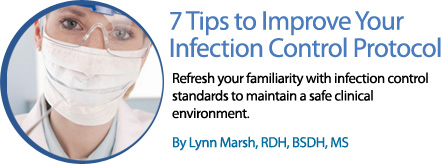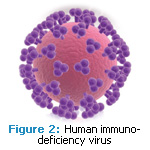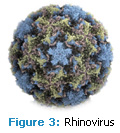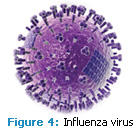
7 Tips to Improve Your Infection Control Protocol
Refresh your familiarity with infection control standards to maintain a safe clinical environment.
The health of dental professionals depends on the prevention of cross-contamination and the strict adherence to infection control protocol. The main purpose of infection control procedures is to provide a safe clinical environment that reduces the potential for disease transmission from clinician to patient, patient to clinician, and patient to patient.1
Standard infection control precautions should be implemented to consistently ensure safe dental treatment for each patient. These procedures allow the oral health care provider to follow the same infection control protocol regardless of the medical history of each patient. The medical history alone will not reliably identify all patients with human immunodeficiency virus (HIV) infection, hepatitis B virus (HBV) infection, or other communicable diseases. Some patients are unaware of their own health status and other patients may choose not to divulge their health status.1 Therefore, prudent infection control procedures should be followed in order to protect oral health care providers as well as their patients.
TABLE 1. SURFACES THAT NEED BARRIER PROTECTION:
- Light handles
- Switches
- Dental radiograph equipment
- Dental chairside computers
- Reusable containers of dental materials
- Drawer handles
- Faucet handles
- Countertops
- Pens
PROTECTIVE GARMENTS
The clinical attire of oral health care providers is susceptible to aerosols, spatter, saliva, and patient contact. Clinical attire should be selected that will protect the oral health care provider from exposure to the skin, mucous membranes, and eyes during the course of dental treatment.
The oral health care provider should wear protective garments such as scrubs, uniforms, and a laboratory coat. A laboratory coat with long sleeves and fitted cuffs is suggested in order to allow gloves to extend over the cuffs for protection of the forearms. Various types of protective garments may be worn to protect the skin from exposure to blood and saliva.2 Oral health care providers should change protective garments daily or sooner if they become noticeably soiled. Garments should be removed prior to leaving the workplace.
The Occupational Safety and Health Administration (OSHA) states that employers are responsible for laundering protective garments and for the provision of disposable garments, in addition to providing adequate protective attire for oral health care providers.1
SURGICAL MASKS
Surgical masks should be worn during all dental procedures. The surgical mask should cover the nose and mouth in order to protect the mucous membranes from exposure to aerosols and spatter produced during various procedures. The surgical mask should never be pulled down underneath the chin or neck area or hang from a name tag because this exposes the clinician to bacteria and pathogens. The surgical mask should be changed between each patient. However, if the surgical mask becomes wet or soiled, it will no longer be an effective barrier and should be changed during treatment.2 After completing dental treatment, the surgical mask should not be removed in the operatory immediately following the use of aerosol-producing procedures as this will allow for direct exposure to airborne organisms.3
PROTECTIVE EYEWEAR
Eye protection should be worn by both oral health care providers and patients to prevent physical injuries and infections to the eyes. Oral health care providers should wear protective eyewear with solid side shields or a face shield during dental procedures. Protective eyewear prevents the mucous membranes of the eyes from contact with microorganisms.2 Protective eyewear should be provided to patients to protect their eyes from aerosols created during dental procedures. Operator loupes/eyewear and patient protective eyewear are reusable and should be cleaned with soap and water as well as disinfected between patients.2
The Centers for Disease Control and Prevention (CDC) and OSHA stipulate that protective eyewear must meet the American National Standards Institute standards for spatter protection and impact protection.1 OSHA requires that employers provide employees with appropriate eye or face protection to reduce exposure from aerosols, spatter, and debris. The employer must provide eye protection with side protection when there is a hazard from flying objects and aerosol spatter. Detachable side protectors are also acceptable.4
HAIR AND HAND HYGIENE
Dental professionals’ hair must be worn off the shoulders. When the operator’s hair is longer, it is recommended that the hair be pulled back off the neck. The hair of the oral health care provider is exposed to a large amount of contamination through aerosols and spatter. As such, an appropriate head cover is recommended but not required when using handpieces and ultrasonic or air polishing instruments.3
Hand hygiene is among the most essential action in the prevention of disease transmission.1 Wearing gloves does not replace the need for proper hand washing. Oral health care providers should properly wash their hands prior to glove application. Gloves used in the dental office may have small defects or may be torn during use, and hands can become contaminated during the removal of gloves. Bacteria thrive in moist environments underneath gloves and nails, therefore, drying the hand thoroughly before and after removing gloves is strongly recommended.2
 |
 |
 |
 |
Dental professionals should keep their nails short, clean, and healthy especially since high concentrations of bacteria can harbor beneath fingernails, even after proper hand washing is conducted.5 Freshly-applied nail polish is acceptable, however, chipped nail polish may encourage the growth of bacteria beneath fingernails.5
Rings and artificial nails should not be worn by oral health care providers. A study found that the variety and quantity of potentially pathogenic bacteria cultured from the fingertips of oral health care providers wearing artificial nails was greater than clinicians with natural nails, both before and after hand washing.5 Moisture tends to become trapped between the natural nail and the artificial nail, causing an increase in fungal growth.5
BARRIER PROTECTION IN THE OPERATORY
The use of impervious surface barriers in the operatory limits the spread of infectious microorganisms. Single-use barrier protection minimizes cross-contamination on surfaces that are difficult to properly disinfect after each patient. Table 1 lists the surfaces appropriate for barrier protection.6 The use of impervious surface barriers will reduce the use of chemicals on these sensitive surfaces while demonstrating the oral health care provider’s dedication to infection control protocol procedures to the patient.
Additionally, routine cleaning and disinfection are recommended for clinical contact surfaces in the operatory including dental unit surfaces and countertops. These clinical contact areas in the operatory should be cleaned and disinfected between each patient, especially since these areas are not frequently barrier protected. Operatory treatment areas, such as countertops, computer terminals, and other fomites, should be kept free of unnecessary equipment and supplies to avoid spatter contamination and decrease cross-contamination.
MICROBIAL SURVIVAL TIME
Proper infection control protocol is vital in preventing microbial contamination within the dental operatory. There are many surfaces on which pathogens can live outside a host cell. Some of the most common surfaces in the dental operatory include: countertops, telephones, door knobs, computer keyboards, and patient charts. These surfaces may contribute to cross-contamination through transient contact by the oral health care provider.7
Hepatitis A and B viruses can survive on surfaces for up to 7 days (Figure 1). Hepatitis C requires blood-to-blood contact and therefore cannot survive outside of a host cell.HIV (Figure 2) can survive as long as it is kept wet but typically lasts for a few hours on surfaces. The common cold virus or rhinovirus (Figure 3) can live on a surface for up to 1 day and the influenza virus (Figure 4) can survive outside of a host cell for up to 2 days.8-11
Direct contact between the oral health care provider and the patient is not the only way cross-contamination occurs. Microbial pathogens can survive on a myriad of surfaces in the oral health care environment.
TABLE 2. ALL HEALTH CARE WORKERS SHOULD BE VACCINATED AGAINST OR HAVE DOCUMENTED IMMUNITY TO THE FOLLOWING DISEASES:11
- Hepatitis B
- Influenza
- Measles
- Mumps
- RubellA
- Varicella
For specific recommendations on the use of vaccines and other immunobiologics among health care workers, click here.
IMMUNIZATIONS
Oral health care providers must keep their immunizations up to date in order to protect themselves from infectious diseases. Proper immunizations are one of the most efficient means of preventing disease transmission. The CDC has restructured guidelines for vaccinations for oral health care providers, increasing the extent of the recommendations beyond OSHA requirements to include other communicable diseases, which may be exposure risks.11 See Table 2 for a list of recommended vaccinations.
CONCLUSION
In the oral health care environment, infection control protocol is essential to minimize cross-contamination. Infection control guidelines, professional association guidelines, and government agency regulations are evidence-based standards that should be followed in the oral health care environment.1 Oral health care providers must comply with these standards and proper infection control guidelines to provide the safest possible dental treatment.
REFERENCES
- Darby M, Walsh M. Dental Hygiene: Theory and Practice. St. Louis: Saunders Elsevier; 2010:79-99.
- CDC. Person protective equipment: Masks, protective eyewear, protective apparel, gloves. Available at: www.cdc.gov/oralhealth/infectioncontrol/faq/protective_equipment.htm. Accessed February 10, 2011.
- Wilkins E. Clinical Practice of the Dental Hygienist. 10th ed. Philadelphia: Lippincott Williams & Wilkins; 2008.
- US Department of Labor. Occupational Safety and Health Standards: Personal Protective Equipment. Available at: www.osha.gov/SLTC/personalprotectiveequipment/index.html. Accessed February 10, 2011.
- Boyce JM, Pittet D, Healthcare Infection Control Practices Advisory Committee, et al. Guideline for Hand Hygiene in Health-Care Settings: recommendations of the Healthcare Infection Control Practices Advisory Committee and the HICPAC/ SHEA/APIC/IDSA Hand Hygiene Task Force. Infect Control Hosp Epidemiol. 2002;23(12 Suppl):S3-40.
- Kohn WG, Collins AS, Cleveland JL, et al. Guidelines for infection control in dental healthcare settings—2003. MMWR Recomm Rep. 2003;52(RR-17):1-61.
- Rutala WA, Weber DJ. Surface disinfection: should we do it? J Hosp Infect. 2001;48 Suppl A:S64-8.
- Hota B. Contamination, disinfection, and cross-colonization: are hospital surfaces reservoirs for nosocomial infection? Clin Infect Dis. 2004; 39: 1182-1189.
- Boyce JM. Environmental contamination makes an important contribution to hospital infection. J Hosp Infect. 2007;65(Suppl 2):50-54.
- Kramer A, Schwebke I, Kampf G. How long do nosocomial pathogens persist on inanimate surfaces? A systematic review. BMC Infect Dis. 2006;6:130.
- Immunization of health-care workers: recommendations of the Advisory Committee on Immunization Practices (ACIP) and the Hospital Infection Control Practices Advisory Committee (HICPAC). MMWR Recomm Rep. 1997;46(RR-18):1-42.
From Dimensions of Dental Hygiene. March 2011; 9(3): 45-46, 48.

